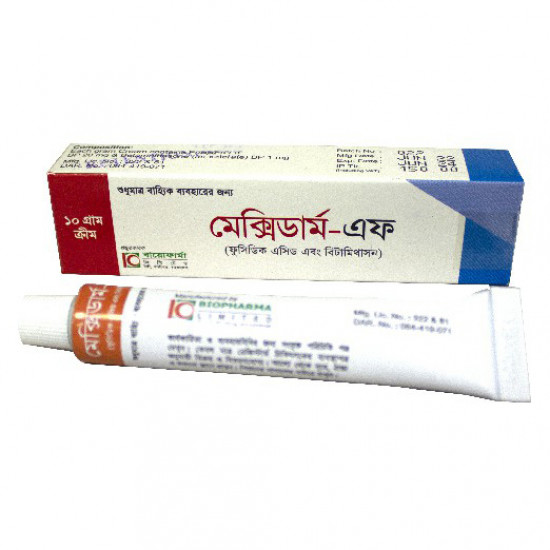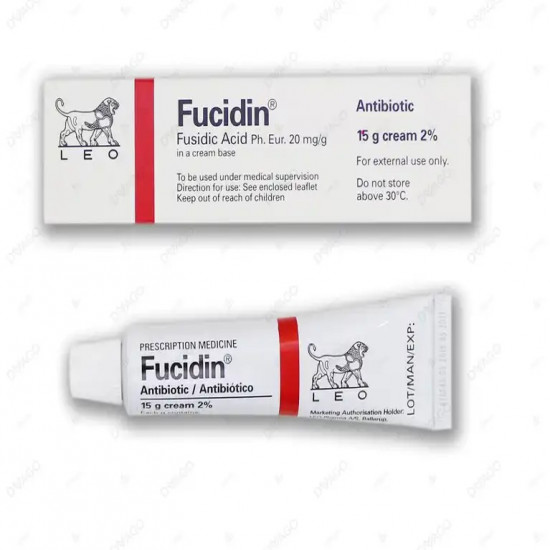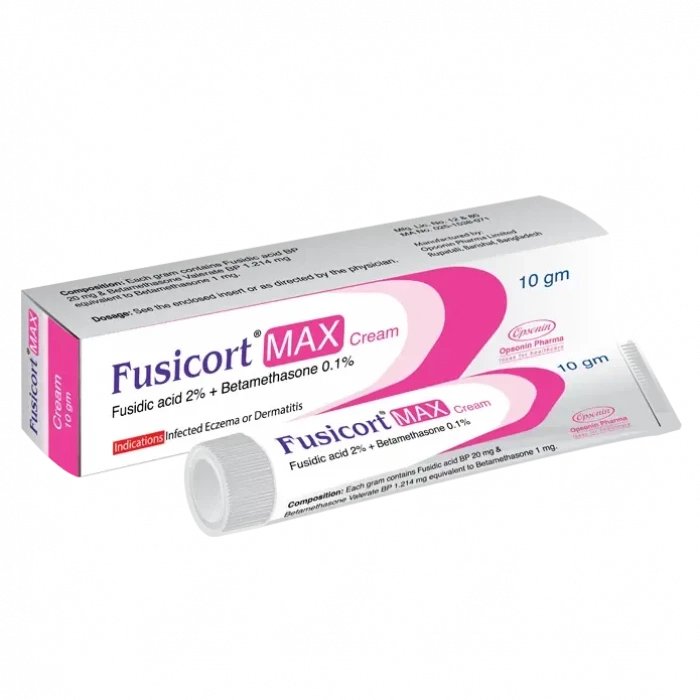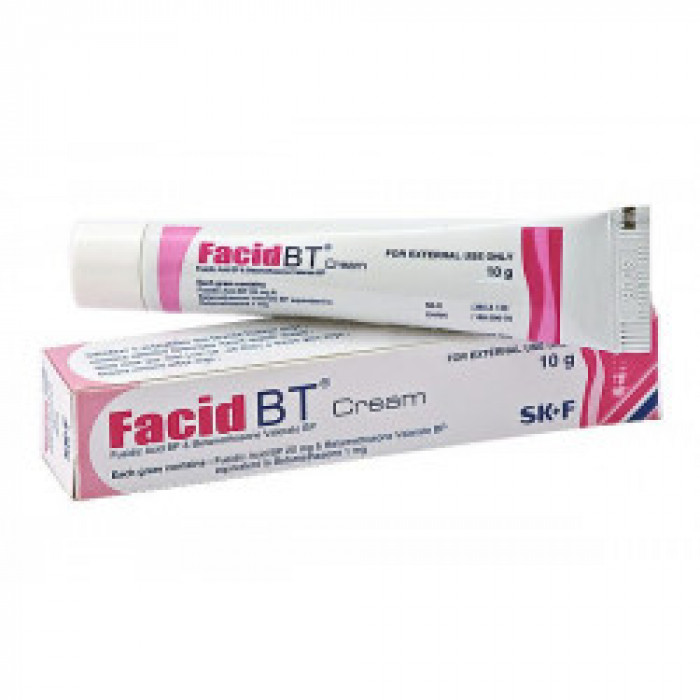
✔ 100% Authentic Product
👁️ Currently Viewing 381
Mexiderm F Cream | 2%+0.1%
Fusidic acid + Betamethasone combines the potent topical antibacterial activity of fusidic acid with the anti-inflammatory and anti-pruritic activity of the moderately potent corticosteroid betamethasone valerate. When applied topically, fusidic acid is effective against Staphylococci, Streptococci, Corynebacteria, Neisseria, and certain Clostridia and Bacteroides. The antibacterial activity of fusidic acid is not diminished in the presence of betamethasone.
Discount
Price: ৳ 147
MRP:
৳
150
2%
Off

100% Genuine Products, Guaranteed

Safe & Secure Payments, Always

Fast, Secure & Efficient Delivery

Proper Packaging
 Cash on Delivery - All over Bangladesh
Cash on Delivery - All over Bangladesh Regular Delivery - 12-24 Hours, Dhaka City* Charge Tk.39-59
Regular Delivery - 12-24 Hours, Dhaka City* Charge Tk.39-59 Regular Delivery - 24-48 Hours, Other Cities* Charge Tk.99-110
Regular Delivery - 24-48 Hours, Other Cities* Charge Tk.99-110
 ফ্রি ডেলিভারিঃ - ৯৯৯ টাকা+ অর্ডারে, ঢাকা
শহরে
ফ্রি ডেলিভারিঃ - ৯৯৯ টাকা+ অর্ডারে, ঢাকা
শহরে ফ্রি ডেলিভারিঃ - ২৯৯৯ টাকা+ অর্ডারে, ঢাকার
বাহিরে
ফ্রি ডেলিভারিঃ - ২৯৯৯ টাকা+ অর্ডারে, ঢাকার
বাহিরে
100% Genuine Products, Guaranteed
Safe & Secure Payments, Always
Fast, Secure & Efficient Delivery
Proper Packaging
 Cash on Delivery - All over Bangladesh
Cash on Delivery - All over Bangladesh Regular Delivery - 12-24 Hours, Dhaka City* Charge Tk.39-59
Regular Delivery - 12-24 Hours, Dhaka City* Charge Tk.39-59 Regular Delivery - 24-48 Hours, Other Cities* Charge Tk.99-110
Regular Delivery - 24-48 Hours, Other Cities* Charge Tk.99-110 ফ্রি ডেলিভারিঃ - ৯৯৯ টাকা+ অর্ডারে, ঢাকা
শহরে
ফ্রি ডেলিভারিঃ - ৯৯৯ টাকা+ অর্ডারে, ঢাকা
শহরে ফ্রি ডেলিভারিঃ - ২৯৯৯ টাকা+ অর্ডারে, ঢাকার
বাহিরে
ফ্রি ডেলিভারিঃ - ২৯৯৯ টাকা+ অর্ডারে, ঢাকার
বাহিরে
✅ Description:
Fusidic acid exhibits activity primarily against Gram-positive bacteria, including Streptococcus, Staphylococcus aureus, and Corynebacterium minutissimum. Its antibacterial effect is achieved through the inhibition of bacterial protein synthesis, where it disrupts the transfer of amino acids from aminoacyl-tRNA to the growing peptide chain on ribosomes.
Betamethasone, a potent corticosteroid, acts by inducing the synthesis of lipocortin, a protein that inhibits the enzyme phospholipase A₂. This inhibition suppresses the formation of inflammatory mediators such as prostaglandins, kinins, and histamine, thereby reducing inflammation, redness, and itching.
Pharmacokinetics:
Fusidic acid demonstrates the ability to penetrate intact human skin, with approximately 2% of the topically applied dose being absorbed. The extent of absorption varies depending on factors like exposure duration and the skin’s condition. It is primarily excreted via bile, with minimal elimination through urine.
The absorption and potency of topical corticosteroids such as betamethasone are influenced by the formulation vehicle. Higher absorption levels are typically observed in areas with thin or compromised skin—such as the face, groin, axillae, or inflamed regions (e.g., atopic dermatitis lesions).
✔️ Uses
Mexiderm-F cream is indicated in eczema and dermatitis with secondary infections, including atopic dermatitis, allergic and seborrhoeic dermatitis, and primary irritant dermatitis.
✔️ Interaction
Other topical (skin-applied) medications contain corticosteroids.
✔️ Contraindications
Topical hydrocortisone is contraindicated in viral tuberculosis and fungal skin infections. Hypersensitivity to any of the components.
✔️ Side Effects
Possible side effects are allergic reactions, headache, skin rash, redness or itching, unusual tiredness or weakness, and yellow eyes or skin.
✔️ Dosage & Administration
Adults: It should be applied 2 times daily and gently massaged into the affected areas for 2 weeks. A shorter course should be considered if symptoms improve.
Children: It is not recommended for children under 3 years of age.
✔️ Pregnancy & Lactation
Fusidic acid and betamethasone should not be used in pregnancy. Both of them have been detected in the breast milk, so nursing mothers are advised not to use the drug.
✔️ Precautions & Warnings
Long-term continuous therapy should be avoided, particularly in the face, on flexures, and intertriginous areas and in infants and children.
✔️ Storage:
Keep out of reach of children. Store in a dry place, below 25˚C temperature, and protected from light.
⚠️Disclaimer:
At ePharma, we’re committed to providing accurate and accessible health information. However, all content is intended for informational purposes only and should not replace medical advice from a qualified physician. Please consult your healthcare provider for personalized guidance. We aim to support, not substitute, the doctor-patient relationship.









